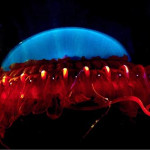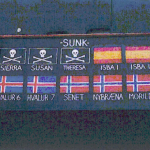This summer, the National Museum of Crime and Punishment (NMCP) is taking a deeper look at injustices happening in our seas. In cooperation with the National Aquarium and the National Oceanic and Atmospheric Administration (NOAA), a new exhibit exposes crime on the high seas, the big business generated from it, and the victims that suffer from it. Sharks, seals and sea turtles are just a few of the victims featured in the new exhibit which debuted this month in recognition of National Oceans Month.
“The recent tragedy of the Gulf oil spill has generated heightened awareness of the injustices brought against the marine life of our world’s oceans, reminding us of the fragility of our world’s wetlands and waters and the species that inhabit them,” said Janine Vaccarello, Chief Operating Officer of the National Museum of Crime & Punishment. “We are extremely fortunate to have the opportunity for this exhibit to come to life in our museum with such national events unfolding.”
The exhibit displays items confiscated by NOAA Special Agents, shown as reminders of why these crimes against marine life occur. These items are made from protected species, and include a sea turtle shell guitar, seal skin and ivory products, and swords made from the beaks of swordfish. Also on display are several comic strips of Sherman’s Lagoon, drawn by renowned cartoonist Jim Toomey. Sherman’s Lagoon appears daily in over 150 newspapers in the U.S. and around the world as part of an effort to dispel many of the negative and unjustified myths that exist about sharks.
“NOAA Fisheries and its Office of Law Enforcement are excited to be partnering with the Crime and Punishment Museum and the National Aquarium to raise awareness of crimes against marine wildlife. Our enforcement activities are an important part of ensuring effective stewardship of our living marine resources,” said Alan D. Risenhoover, acting director of NOAA’s Office of Law Enforcement. The exhibit also features the National Aquarium’s Marine Animal Rescue Program (MARP) to demonstrate how these crimes affect marine life. MARP rescues, rehabilitates and releases marine animals in Maryland. The program has successfully rescued, treated and returned more than 83 animals to their natural habitats including: seals, dolphins, porpoises, pilot whales, pygmy sperm whales, sea turtles, and a manatee.
“Humans are responsible for more than half of marine animal strandings that are reported to our Marine Animal Rescue Program,” said National Aquarium Executive Director Bob Ramin. “We’re proud to partner with NOAA and the Museum of Crime & Punishment to showcase our rescue program in this exhibit, and draw attention to the injustices that occur to marine animals on the high seas.”
A special section of the exhibit is dedicated to bringing awareness to shark finning, which is the removal of fins from live sharks for commercial gain. Shark finning is illegal in the U.S. and results in the inhumane treatment and death of sharks. The worldwide demand for shark fins is causing overfishing and further depletion of marine life. The special section highlights the increased problems with shark finning and its effects, as well as showcases an actual closed case.
NOAA’s Office of Law Enforcement enforces laws and regulations to protect fish stocks from overfishing, marine mammals from depletion, and endangered species from extinction. While NOAA’s Office of Law Enforcement has responsibility for enforcing more than 39 federal statutes, most cases fall under five key legislative acts, including the Marine Mammal Protection Act of 1972, the Endangered Species Act of 1973, the Lacey Act Amendments of 1981, the Magnuson-Stevens Fishery Conservation Act of 1976, and the National Marine Sanctuaries Act.
Share the post "Crimes Against Marine Life Exhibit Now Open at National Museum of Crime & Punishment"






I hope I can visit the exhibit — sounds wonderful and should indeed have some educational value. However, as a minor, quibbling point, I would note that swords and other scrimshaw made from the bills of swordfish are not illegal per se as long as they were taken from legal-sized fish.